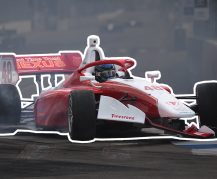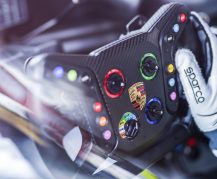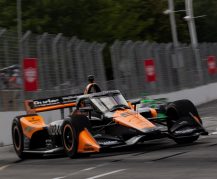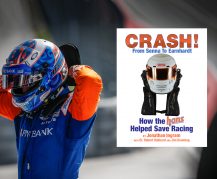This year, we have welcomed an array of top driving talent who have offered advice in our Ask a Pro section. From ex-Formula One drivers through to a five-time Le Mans winner and the current IndyCar champion, they have answered your questions in detail, covering a variety of subjects, such as fitness, mental concentration and racecraft. We have chosen the top 10 pro tips from 2014 to help with your racing development.
How can an amateur with little funding get started in racing?
Oliver Gavin (Four-time Le Mans class winner): Any driver will tell you how difficult it is these days; it’s never been easy but it’s even more difficult in today’s economy. Most people will start in karting to learn their race craft and that’s what I did. My Dad bought a kart for my brother and we used to run it, with us learning how it worked and how to work on it, all really good training for the future.
From there I moved onto car racing, with my Dad paying the way to begin with and then with some sponsorship as I moved up. Getting sponsorship is mostly about who you know, rather than what you know. But think about what you can do for a sponsor instead of what they can do for you and you’ll have more success. Anyone can go karting, at any age, or you could do something like stock cars or dirt racing…do whatever you can within your budget and have fun. Good luck!
My 9 year old is pursuing his dream of being a professional driver. What path did you take in your early years and what was the most valuable part of those years that feeds your racing today?
Bruno Senna (Ex-Formula One driver and GP2 race winner):I had a very disrupted career as I stopped racing between 10 and 20 years old, so definitely not the most traditional way. Regardless of that, the best way for a driver to have a real chance in racing is for he or she to go through the steps in a structured manner.
Spend a few years in karting and search for the most competitive championships to learn race craft. Then move on to junior single-seater series or GT cars. Always aim for the highest level you can find or afford as this will always give you an indication of how competitive the driver can be and how far he can make it. The most important advice however is to be able to dream but not exclude other options outside of Formula One as there are plenty of great championships to race in.
SAFEisFAST.com Video: Making the Transition from Karts to Cars
I am currently racing in Skip Barber and looking to move up to US F2000. When moving to a new team, how can I make sure I find the right team with a fast car and one that will fit with my personality?
Oliver Gavin (Four-time Le Mans class winner): You have to do your research carefully, find out all you can about the team rather than looking only at results, but to be honest at your level it’s as much about whether they like you as whether you like them. Don’t just look at the last season’s race results, but look at practice and qualifying too…they might have had a great car which is more than an equal to the eventual race winner’s, but the driver used to go to pieces in qualifying or something like that. Don’t just go to the team that has won, go to several and see how they approach racing so you can find the one that suits you. Talk to the engineer as well as the team boss, as you’ll spend more time with him than the boss!
How difficult do you find it to adapt to a new race engineer? What do you suggest to speed up the communication process?
Graham Rahal (IndyCar Series race winner): It’s always difficult. A race engineer and his driver must always be on the same page. An engineer should be able to look into his driver’s eyes and know what he’s thinking before he says a word. Any sort of relationship-building time like dinners together, team meetings, phone calls – all those things – so you both get on the same page is always a big help. Relationships make this world go around, and Bill [Pappas] and I work very hard on this all the time.
SAFEisFAST.com Video: Working with an Engineer
Karun, You have had experience across the whole motor racing spectrum, how often have you had assistance from a driver coach? Also, how many drivers actually seek professional coaching? It is rarely mentioned as a part of a successful drivers experience although I know many drivers all the way up at F1 level still have some coaching even they may be race winners, just like professional golfers and tennis players have a coach.
Karun Chandhok (Ex-Formula One driver and GP2 race winner): Great question! I was always a believer in driver coaches. It’s funny how many drivers actually believe they don’t need a coach, but as you say, if Rafa Nadal, Tiger Woods or Lionel Messi still have coaches, then why should we be different? When I was in Formula 3, I worked with Andy Priaulx, who is now a multiple World Touring Car Champion and he was fantastic. I still work with Rob Wilson, a Kiwi driver coaching legend. Rob is a great observer of drivers and has a fantastic critical eye for what drivers are doing. I know a number of drivers on the current F1 grid who owe a few tenths to Rob.
SAFEisFAST video: The Driver Coach
As a racing driver fitness and diet is key but how do I know what is enough to eat and the right foods? What’s a typical race day menu for you?
Bruno Senna (Ex-Formula One driver and GP2 race winner): Food is so important in a racing driver’s life. To keep fit, you need to eat well and do lots of training as you know but you also have to find out the foods that agree with your stomach when you’re under stress. I’m a bit peculiar as I have intolerances to rice and eggs, so I can’t eat those around a race weekend but rice and pasta are great sources of carbs to eat before a race, together with either, grilled fish, chicken, turkey and vegetables as you like them cooked. Don’t forget your hydration is at least as important as the food, so drink lots of water or drinks with electrolytes when the day is very hot and you sweat a lot.
SAFEisFAST.com Video: Nutrition: Fuelling the Driver
I race shifter karts and also do some simulator racing to practice my focus points on turn-in, apex and exit. I notice at times that I tend to “tighten up” or stop breathing. Not sure if you have experienced that before. I notice that I lose tenths of a second when I am in that state. Is there a way to get back to a state of relaxed focus? I have read Jacques Dallaire’s book and I still struggle at times with the focus.
Graham Rahal (IndyCar Series race winner): Of course. We all experience that. I have noticed it on the simulator before, as well as in the car. Honestly, I think it’s all about time in the car. The more you drive it, the more comfortable you become. However, when you are pushing to 10/10ths, you will always have some sort of heightened heart rate or slower breathing. This is normal. The most important thing is to make sure you’re in good enough physical shape to sustain this and to keep your mind clear so you aren’t making mistakes, getting sloppy, when your heart rate ramps up. It will always happen, and it has always happened to all of us.
SAFEisFAST.com Video: Focus and Concentration
How do you keep your focus for an entire race distance?
Karun Chandhok (Ex-Formula One driver and GP2 race winner): I always try and focus on the laptime and try to develop a rhythm that allows me to drive at a consistent pace. You focus on doing the laps one by one within as small a variance as possible. Getting good references for braking is key for this I find, so you can repeat the way you drive that particular corner in the same way lap after lap.
SAFEisFAST videos: Focus and Concentration and The Mental Edge
As an aspiring racer who races at an indoor karting facility, I’m constantly looking to improve my lap times, so if I want to achieve that where do I start?
Will Power (2014 IndyCar Series champion): You always start with understanding what is the quickest time around there and who set the quickest time. Then you should race against faster guys so that you can start to see and understand where you need to go faster, what lines are better/worse and how to close up on people, using a different line and understand where you lose time. Then you’ll start to work it out and start working on the details.
SAFEisFAST.com video: The Fast Line
Have you had to use degressive braking techniques and which car did you use them in?
Derek Bell (Five-time Le Mans winner): I have to say I have never been one to lock up brakes that much but it happens from time to time when in sheer panic you keep your right foot down too hard. In sports cars we always had that compromise to not lock up the wheels otherwise we were going to lose time and have extra tyre changes apart from brake wear! As John Wyer used to say you need: ‘Good hands.’
SAFEisFAST.com video: Braking
 Road Racing Drivers Club
Road Racing Drivers Club
 Share
Share
















